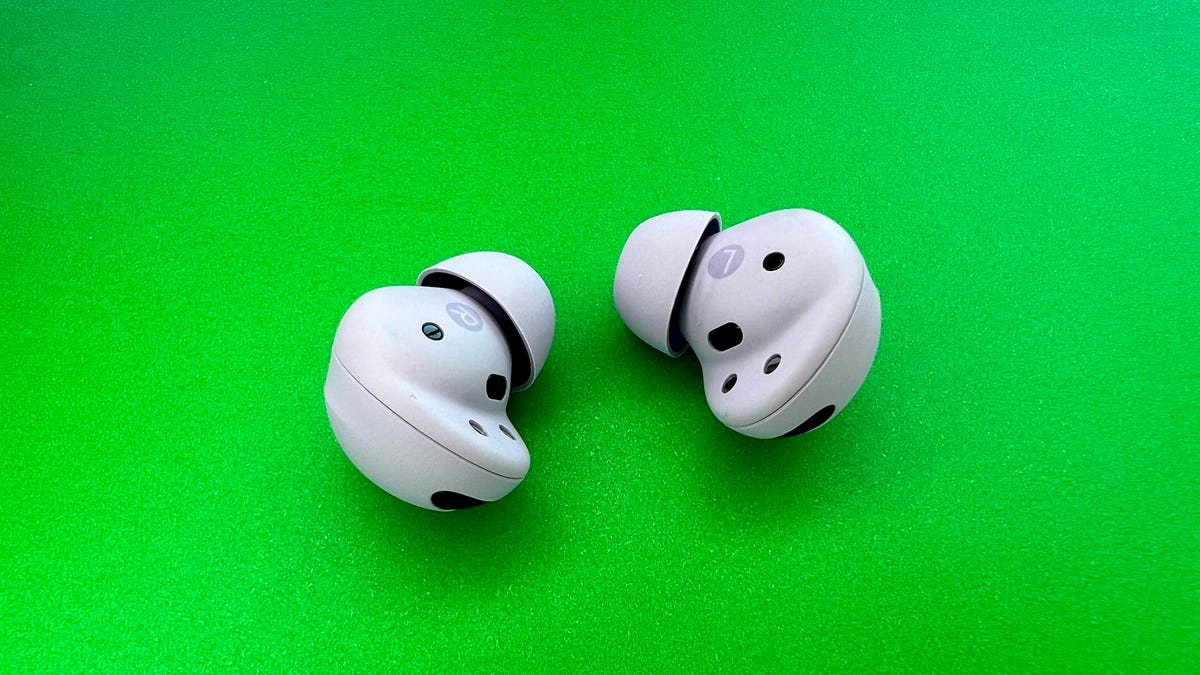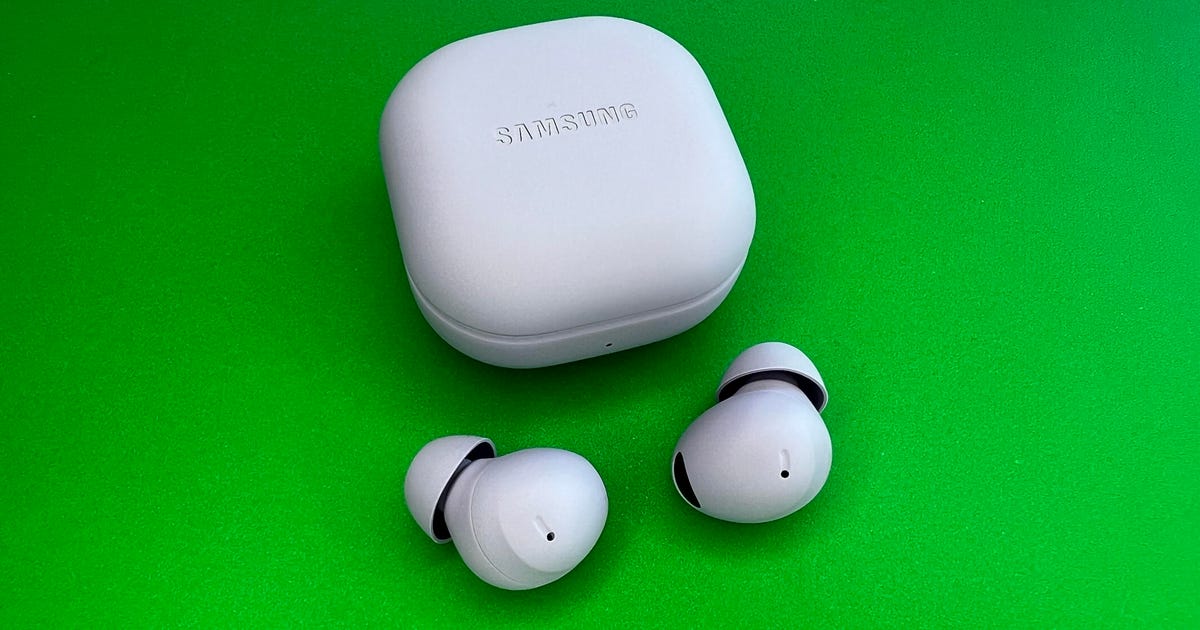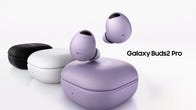When Samsung launched its original Galaxy Buds Pro noise-canceling earbuds, one of its headline marketing messages was the attention it paid to their sound quality. Indeed, they delivered on that front, but a certain subset of users, including me, found them to be a less-than-ideal fit for their ears. In my case, none of the included ear tips allowed me to get a tight seal, so I had to swap in a larger set of tips from a rival set of earbuds. So, needless to say, I was curious to see what Samsung’s engineers had come up with for the second-gen Galaxy Buds 2 Pro ($230, £219, AU$349), suspecting they’d address that fit issue.
Like
- Improved design with more comfortable fit
- Excellent sound and good noise-canceling
- Very good voice-calling performance
- Assortment of extra features for Galaxy device owners, including 360 Audio virtual surround sound and hands-free Bixby voice assistant
- Fully waterproof (IPX7)
Don’t Like
- Fairly pricey
- Some key features only work with Samsung devices
- No true multipoint Bluetooth pairing
Sure enough, they did. The first thing you’ll notice about the Samsung Galaxy Buds Pro 2 — which are launching alongside the new Samsung Galaxy Z Flip 4 and Galaxy Z Fold 4 — is that they simply have a better all-around design than their predecessor. Not only are they 15% smaller, according to Samsung, but they have a matte finish on both the buds and case that gives them a nicer feel and makes them a bit more grippy.
Read more: Best Wireless Earbuds for 2022
That makes the compact case a little less likely to slip out of your hand and — more importantly — it helps keep the buds in your ears a little more securely. And thanks to their new shape and smaller size, I was able to get a tight seal with the largest set of included ear tips and didn’t have to supply my own. Additionally, the earbuds don’t stick out of your ears as much as the original Galaxy Buds Pro did, and they look more discreet. They’re available in three colors — Bora purple, white and graphite — and while I can’t say they’ll fit all ears equally well, they should provide a better fit to more ears than the original Galaxy Buds Pro.
Proprietary high-res audio and other Galaxy-exclusive features
Aside from the revamped design, Samsung is touting the buds’ improved noise canceling and support for 24-bit high-resolution audio. The catch is to get that 24-bit audio you’ll need a Galaxy device equipped with Samsung’s One UI 4.0 and a music streaming service like Qobuz, Tidal or Amazon Music that streams high-res audio tracks. On all other devices, including Android phones and iPhones, the buds default to the AAC audio codec. They use Bluetooth 5.3.
Alas, the Galaxy Buds 2 Pro don’t support the more common AptX Adaptive audio codec for Android devices, only the new Samsung Seamless Codec Hi-Fi codec, which Samsung says delivers 256x more sound data than 16-bit (CD quality) audio. Numbers like that are a bit deceptive because, based on my experience, you’re really only going to notice a slight difference when streaming higher bit-rate tracks. But more on that after I round out the rest of the feature set.
The buds didn’t stick out of my ears too much.
David Carnoy/CNET
Like their predecessor, these have touch controls (you can turn certain ones on or off, or you can turn them all off) along with an option to activate hands-free Bixby, Samsung’s voice assistant. Additionally, Samsung’s 360 Audio virtual surround feature (with head tracking) returns in an “Enhanced” version and now works with a variety of Galaxy devices out of the gate, though it’s not compatible with other Android devices. It works along the same lines as Apple’s spatial audio feature for AirPods and can enhance your movie and TV watching experience, though it doesn’t seem to be as pronounced Apple’s spatial audio, which I think is slightly better overall. It also works with music or any audio you’re listening to.
The Galaxy Buds 2 Pro are IPX7 water-resistant, which means they can withstand being fully submerged in 1-meter deep water for up to 30 minutes. I had no problem running with them and they didn’t slip out of my ears.
Like their predecessor, battery life is rated at 5 hours with noise canceling on and 8 hours with it off at moderate volume levels, with about three additional charges in the case (it charges via USB-C and wirelessly). You could quibble that no improvements have been made to the battery life, but it’s hard to shrink buds while increasing battery life.

The Galaxy Buds 2 Pro have three microphones on each earbud along with ear-detection sensors.
David Carnoy/CNET
Sensors detect when the buds are in your ears and will pause your music when you take a bud out and resume playback when you put the bud back in (you can use a single bud while leaving the other one in the case). Additionally, you can opt to activate a “voice detect” mode in the Galaxy Wearable companion app that automatically turns off noise canceling and switches to “ambient sound” mode when you speak, allowing you to hear the outside world and engage in a conversation with someone. Sony offers a similar feature with its WF-1000XM4 and LinkBuds S earbuds.
Another new feature worth mentioning has nothing to do with audio. You can toggle on the “neck stretch reminders” setting that detects your head position and alerts you when you’ve bent your head downward for 10 minutes. As I’ve written this review, I’ve been alerted several times to stretch my neck.
Like the AirPods and some other earbuds these have a find-my-buds feature that Samsung calls SmartThings Find. It can tell you your location when the buds were last connected to your device, but it doesn’t offer the more precise tracking capabilities of Apple’s enhanced Find My in its latest AirPods.
Lastly, like their predecessor and the more affordable Galaxy Buds 2, the Galaxy Buds 2 Pro don’t offer true multipoint Bluetooth pairing that allows you to pair them with two devices, such as a phone and computer, at the same time. But Samsung says they seamlessly pair with all the Samsung devices logged into your Samsung account, including Samsung TVs built in 2022 or later and Samsung Galaxy Books laptops built after 2020.
The Buds 2 Pro offer automatic switching between those devices. So if, for instance, a call comes in on your phone as you’re watching a movie on your Tab S8 tablet, the audio will automatically switch to your phone when you answer the call. That’s similar to how Apple’s AirPods auto pair with any Apple devices logged into your iCloud account. Note that I haven’t thoroughly tested the auto-switching feature with many Samsung devices (because I only own a few) so I can’t confirm exactly how reliable it is. I spent more time manually switching my audio between a Galaxy Flip 3 and non-Samsung devices.
Impressive all-around performer
Samsung says it’s improved the noise canceling on the Galaxy Buds 2 Pro by 40% (it calls it “Intelligent ANC”). I found it an improvement on the original Galaxy Buds Pro, but noise-canceling performance is affected by how tight a seal you get from the ear tips (as is sound quality), so your perception of how much it’s improved may vary by how good a seal you get.
I thought the noise canceling was close but not quite there, compared with the noise canceling of the Sony WF-1000XM4, but it did a good job muffling a variety of noise on the streets of New York and underground in the subway. You can turn the noise canceling off or activate ambient mode, the equivalent of Apple’s transparency mode, which I thought sounded natural. But there’s no setting to adjust noise canceling levels; it automatically adapts to your environment.
The Galaxy Buds 2 Pro are equipped with two-way drivers (10mm woofer, 5.3mm tweeter) and three microphones, two of which are beam-forming for voice calls. I paired them with a Galaxy Z Flip 3, iPhone 13 Pro and Google Pixel 4 XL and streamed music using Qobuz. I also streamed some movies from Google Play and Netflix.
According to Samsung, there’s no way to check whether you’re getting 24-bit audio (nothing indicates whether you are — or aren’t), but if your audio setup meets the requirements listed — a Galaxy phone with Android 8.0 or higher and One UI 4.0 or higher with at least 1.5GB of RAM — you’ll be using the Samsung Seamless Codec, which transmits in 24-bit, assuming your audio files support it. (Qobuz files do.) I find it irritating that there’s no way to tell what bit rate you’re streaming at, but I’ll have to take Samsung’s word that I was getting 24-bit audio.
I did notice a slight difference when streaming with the Galaxy Z Flip 3. However, using the iPhone 13 Pro, the sound quality was also very good with an amply wide soundstage. I went back and forth with Spoon’s Knock Knock Knock track and a few other songs. The Flip 3’s sound came across slightly more accurately (a bit more clarity) with a touch more detail and depth. The bass is punchy and well-defined and I didn’t experience any noticeable distortion at higher volumes. In short, they’re excellent-sounding buds, though I’m not sure they’re superior to other top earbuds in their price range, including the Pixel Buds Pro, Beats Fit Pro and Sennheiser Momentum True Wireless 3.
I mostly went with the default sound setting, though you can tweak the signature profile in the Galaxy Wearable app with some preset equalizer settings, including a bass boost setting. The truth is a lot of these premium earbuds are starting to sound pretty similar and it’s really the fit — and how they fit your particular ears — that’s going to make you like one more than another.
I’ll finish by saying that once again Samsung has delivered a set of Galaxy buds that work as a headset for making calls. They have good voice pick-up from the beam-forming microphones while providing good background noise reduction. Callers said they could hear me relatively clearly in the noisy streets of New York and the buds did a decent job reducing wind noise. They’re in the upper echelons in terms of voice-calling performance.
Galaxy Buds 2 Pro final thoughts
For better or worse, Galaxy Buds have always been an accessory for Galaxy smartphones and, as a result, more geared toward owners of Galaxy devices. The Galaxy Buds 2 Pro are no exception. They’re excellent earbuds, but you lose some of their key features if you’re not a Galaxy device owner. For that reason, it’s easy to see them as the Samsung equivalent of the AirPods Pro, which may very well get some sort of high-resolution wireless streaming option with the arrival of the AirPods Pro 2 that will likely use proprietary Apple technology that only works with its devices.
By comparison, the Pixel Buds Pro have fewer features geared exclusively toward Pixel owners (virtual surround), and such features as hands-free Google Assistant and true multipoint Bluetooth pairing are available across all Android devices. However, the Pixel Buds have no enhanced audio codec support, which may be important if you’re convinced it makes a big difference. I personally think it makes only a slight difference with this class of earbuds, which may have a premium price tag but aren’t high-end.
The bigger question will be whether it’s worth upgrading to the Galaxy Buds 2 Pro if you already own a pair of Galaxy Buds, particularly the original Galaxy Buds Pro. I think that will largely depend on what price you can get the Galaxy Buds 2 Pro for. While their list price is $230, Samsung is currently offering trade-in deals (any Galaxy Buds in any condition) that bring their price down to around $155 and you can often get deals on them as part of a bundle with a new Galaxy phone.
For me anyway, while the Galaxy Buds 2 Pro offer some small performance improvements over their predecessor, their design is the biggest upgrade. That makes them the best Galaxy Buds yet.


















%20(2)%20(1).jpg)


Discussion about this post